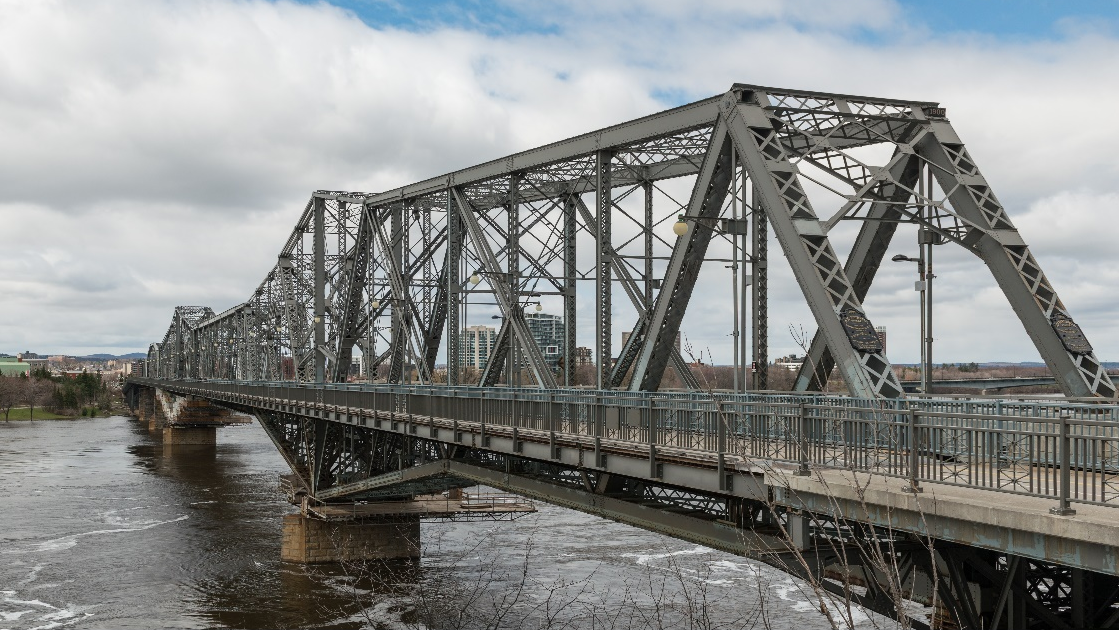
Site Location: Lat.: 45° – 25’ – 48” N; Long. 75° – 42’ – 15” W. (GPS: 45.4301181,-75.7040656). Exit Highway 417 at Nicholas Street and continue northwest 1.6 km to Daly Avenue. Turn left (west) on Daly and, after 0.3km, right (northwest) on Col. By. Drive, and continue 0.8 km to park at the National Gallery of Canada, on the left (west). Walk west approximately 0.5 km to the bridge. On foot, walk north along Sussex Drive to St. Patrick St, turn left and continue 0.5 km to the bridge.
Plaque Location: The plaque is mounted on the west railing of the bridge, near the south west corner of the pedestrian deck

Description: The Alexandra (or Interprovincial) Bridge spans the Ottawa River between Ottawa and Hull. It is a steel cantilever truss with clear spans of 320 m (1045 ft. 9 in.) and a total length between abutments of 818m. (2685ft.). It was owned by the Interprovincial Bridge Company, later part of the Canadian Pacific Railway, with H. J. Beemer of Montreal as President and G. C. Dunn as Chief Engineer. The design and construction of the steel superstructure was awarded to the Dominion Bridge Co. Ltd. of Lachine, with G. H. Duggan as Chief Engineer and F. P. Shearwood as Assistant. Work on the substructure started in 1898, and the first locomotive crossed the bridge on December 12, 1900. The name was changed in September 1901 to the "Royal Alexandra Bridge" in honour of the new Queen, the wife of Edward VII, during the visit of her son, the Duke of Cornwall and York, later George V. The original railway track and two pedestrian footpaths ran between the trusses, with cantilevered decks for road and streetcar traffic. Ownership was transferred to the National Capital Commission in 1970 and the bridge is now owned by Public Works Canada.

Historic Significance: The Alexandra Bridge was designed and constructed by Canadian engineers at a time when most major works in Canada were designed and built by non-Canadian firms. At the time of its opening it was the fourth longest cantilever (pin-connected truss) span in the world. The use of mild steel for the superstructure and concrete for the foundations was novel. Excavation for the main piers was hindered by the presence of up to 7.6m (25ft.) of sawdust, wood slabs and logs from the lumber mills upstream. Timber cribs were founded on the bedrock and concrete was placed in them, underwater, by kibbles” (bottom opening steel buckets)’, supported by four scows anchored in the river. The superstructure contract was an important source of income for the fledgling Dominion Bridge Co. Ltd.
G. Herrick Duggan (1862-1946) was a successful engineer and businessman who designed and raced yachts. He held different positions at Dominion Bridge Co. Ltd. for over 50 years, starting in 1886, including President 1919-1936, and was President of the Canadian Society for Civil Engineers and the Engineering Institute of Canada in 1916. F. P. Shearwood was also Chief Engineer and succeeded Duggan as President of the company.

Plaque Wording: Site Historique National de Génie Civil. SCGC. PONT ALEXANDRA (INTERPROVINCIAL). La construction du Pont Alexandra a fait appel aux technologies les plus avancées disponibles á l’époque, témoignant ainsi de l’ingéiosité et de la prévision tout á fait remarquables des ingénieurs canadiens. G. Dunn, Ingénieur en chef des Chemins de fer. H. J. Beemer, Entrepreneur générl. C. H. Deans, Entrepreneur, Piles. Dominion Bridge Company, Superstructure. Début de la construction, février 1898. Inauguration, mars 1901. Commémoration, juin 1995. Société canadienne de genie civil.
CSCE. National Historic Civil Engineering Site. ALEXANDRA (INTERPROVINCIAL) BRIDGE. Constructed using the most advanced technologies available at the time, the Alexandra Bridge stands today as evidence of the outstanding ingenuity and foresight of Canadian Engineers. G. Dunn, Chief Railway Engineer. H. J. Beemer, General Contractor. C. H. Deans, Contractor, Piers. Dominion Bridge Company, Superstructure. Start of Construction, February 1898. Inauguration, March, 1901. Commemoration, June 1995. Canadian Society for Civil Engineering.
Plaque Unveiling Ceremony: (June, 1995)
Links to Online Documentation:
F. P. Shearwood, “Superstructure of the Interprovincial Bridge, Ottawa”, CSCE Transactions, 1901.
“The Interprovincial Bridge at Ottawa”, The Engineering Record, 1901.
“The Centenary of the Interprovincial Bridge”, Branchline, 2001